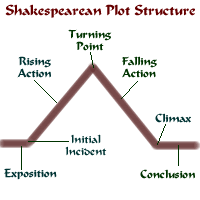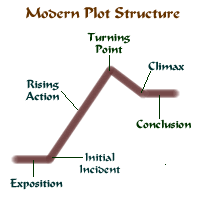

Unit
Four - Script Analysis
Module 1: Play Structure
Lesson 2- Play Structure
Introduction:
The purpose of this lesson is for students to become familiar
with the structure of plays.
Objectives:
- to understand the historical and cultural influences on a play
- to
understand
how plays are made
- to understand the contributions of various dramatic artists
to a theatrical production
Resources:
journal
CELs:
C, IL
Components:
Cultural/Historical
Activities:
Activity
1 - Read the Background Information:
Students should read the following background information. It
may be most effective if you read it as a group, and discuss as
you go.
What
is a play?
A play is based on plot, or events. It usually has a central
conflict that powers the story. It is arranged in conversations
called dialogue. Groups of dialogues or episodes are called a
scene. Scenes are used to show when time or place change. Large
shifts in time or place are marked by acts, which are usually
composed of several scenes.
Plot
The plot of any play is simply what happens. In a modern play,
there is a standard plot structure.
Initiating
Action - the event that triggers the other events of the play
(This may not be the first thing in a play as many plays contain
exposition, the information on key past events that the audience
does not see.).
Rising
Action - series of events that heighten the conflict between
the protagonist force and antagonist force.
Turning
Point - the most dramatic scene where either the protagonist
or antagonist gains advantage.
Falling
Action - series of events in the plot after the turning point
but before the climax. The results of the rising action.
Climax
- the peak of the play, resolves the conflict between the protagonist
and antagonist forces, as one of them "wins".
Conclusion
- plot is completed and the loose ends are tied up.
| As
theatre has developed throughout the decades, the way these
elements are structured has radically altered. Greeks focused
on talking a lot about what happened before and after the
action, so the structure has large falling and rising action. |
 |
 |
The
Elizabethan theatre, which Shakespeare wrote for was afternoon
entertainment. Some companies staged as many as 15 pays a
month, so similar structure in all plays was important. Directors
emphasized action, the comedy of the low characters and the
struggles of the hero. |
|
Modern
plays have a wide variety of plot devices and types of events,
but they still rely on a basic structure. The focus on the
building of action to the turning point provides drive for
the play. As a director, building and maintaining focus,
tension and theme are important.
Some
contemporary playwrights, such as Beckett, deliberately
break from this structure (use no discernible plot structure
or climax) to challenge convention.
|
 |
Theme:
Theme is the main idea that the plot develops. It gives the purpose
to the action. It is the job of the actors to reveal the theme
to the audience. Plays with strong themes have the most long-lasting
impact on the audience.
Style:
The way the place is written is called the style. Style may
be sparse, descriptive, humorous or sarcastic. The actor and director
need to reflect the playwright's style in the production as a
whole.
Setting:
Setting is where and when the play occurs. As the set is built,
the play is referred to constantly. All details in the design
must reflect the style plot and theme of the play.
Characters:
The people that power the plot of a play. Characters are played
by actors and must be consistent with the other elements of the
play. See unit three on characterization for extra detail on this
subject.
Activity
2 - The Moving Diagram:
One student has a copy of three play structure diagrams. This
student is the Caller for the group. The Caller calls out
one of the three play structures and the other students lay
on the floor to make the shapes. Then the caller says "Sound
Off!", then the students say which part of the plot structure
each of them is. Some parts may be formed by more than one
student. With enough actors, this game can be done as a competition
to see who is fastest. |
Activity
3 - The Journal:
Students should read the materials on the structure of drama.
They should create an outline for a play in their journals
using a modern plot structure. Students should list the characters,
theme, setting and style they would use. They should write
a brief scene (1/2 page to 1 page) to demonstrate their writing
styles. |
 |
Instructional
Strategies: Mastery Lecture
Evaluation:
Journals will be taken in and evaluated as a whole several times
throughout the class.
On-line
Activity Alternatives: Journals are submitted electronically.
Next
Lesson / Student
Lesson /Previous Lesson











